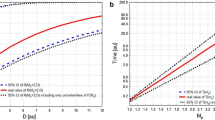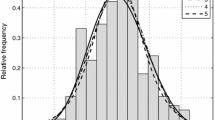Abstract
This study is devoted to application of some new statistical methods to analysis of the spatial structure of the seismic field in a seismically active region in the neighborhood of Japan bounded by the following coordinates: 28°–50° north latitude, 130°–150° east longitude. The estimates of the seismic flux were obtained by using the k-nearest neighbors method for the magnitude interval m ≥ 5.2. The highest values of seismic flux intensity of about 10–4 \(\frac{1}{{{\text{year}}{\kern 1pt} - {\kern 1pt} {\text{k}}{{{\text{m}}}^{{\text{2}}}}}}\) are located at depths of down to 100 km and manifest themselves in the neighborhood of the Tohoku megathrust earthquake. The spatial resolution of the intensity estimates is ranging from 33–50 km in the regions with a high intensity to 100 km and larger in the zones with a weak intensity. It has been shown that the seismic filed parameters—intensity λ, slope of the magnitude–frequency graph β, maximum possible magnitude m1—have different scales of their spatial variability and, thus, it is necessary to apply different scales of spatial averaging to them. Based on the Gutenberg—Richter truncated distribution model, the estimates are obtained for the slope of the magnitude–frequency graph (b‑value) and the upper boundary of the distribution m1. An original method is proposed for determining the optimal averaging radius for an arbitrary cell of the space grid. The method is based on the use of the statistical coefficient of variation of the corresponding parameter. For the considered region, the estimate of the maximum possible magnitude Мmax = 9.60 \( \pm \) 0.41 was obtained with consideration of the correction for bias.










Similar content being viewed by others
REFERENCES
Aki, K., Maximum likelihood estimate of b in the formula log(N) = a – bM and its confidence limits, Bull. Earthquake Res. Inst. Tokyo Univ., 1965, vol. 43, pp. 237–239.
Beirlant, J., Kijko, A., Reynkens, T., and Einmahl, J., Estimating the maximum possible earthquake magnitude using extreme value methodology: The Groningen case, Nat. Hazards, 2019, vol. 98, pp. 1091–1113. https://doi.org/10.1007/s11069-017-3162-2
Bender, B., Maximum likelihood estimation of b values for magnitude grouped data, Bull. Seismol. Soc. Am., 1983, vol. 73, no. 3, pp. 831–851. https://doi.org/10.1785/BSSA0730030831
Cramer, H., Mathematical Methods of Statistics, Princeton: Princeton Univ. Press, 1940.
Efron, B., Bootstrap methods: Another look at the jackknife, Ann. Stat., 1979, vol. 7, no. 1, pp. 1–26. https://doi.org/10.1214/aos/1176344552
Gutenberg, B. and Richter, C., Seismicity of the Earth, New York: Princeton University Press, 1954.
Holschneider, M., Zöller, G., and Hainzl, S., Estimation of the maximum possible magnitude in the framework of the doubly truncated Gutenberg–Richter model, BSSA, 2011, vol. 101, no. 4, pp. 1649–1659. https://doi.org/10.1785/0120100289
Kanamori, H., The energy release in great earthquakes, J. Geophys. Res., 1977, vol. 82, no. 10, pp. 2981–2987. https://doi.org/10.1029/JB082i020p02981
Khan, P.K., Manoj, G., Chakraborty, P.P., and Mukherjee, D., Seismic b-value and the assessment of ambient stress in Northeast India, Pure Appl. Geophys., 2011, vol. 168, pp. 1693–1706. https://doi.org/10.1007/s00024-010-0194-x
Kijko, A., Estimation of the maximum earthquake magnitude, m max, Pure Appl. Geophys., 2004, vol. 161, pp. 1655–1681. https://doi.org/10.1007/s00024-004-2531-4
Kijko, A. and Singh, M., Statistical tools for maximum possible earthquake estimation, Acta Geophys., 2011, vol. 59, no. 4, pp. 674–700. https://doi.org/10.2478/s11600-011-0012-6
Kolathayar, S., Sitharam, T.G., and Vipin, K.S., Spatial variation of seismicity parameters across India and adjoining areas, Nat. Hazards, 2012, vol. 60, pp. 1365–1379. https://doi.org/10.1007/s11069-011-9898-1
Latchman, J.L., Pisarenko, V., and Rodkin, M. Heavy-Tailed Distributions in Disaster Analysis, Math. Geosci.s, 2010, vol. 43, pp. 501–502. https://doi.org/10.1007/s11004-011-9339-4
Marzocchi, W. and Sandri, L., A review and new insights on the estimation of the b-value and its uncertainty, Ann. Geophys., 2003, vol. 46, no. 6, pp. 1271–1282. http://hdl.handle.net/2122/1017.
Pisarenko, V.F., Statistical evaluation of maximum possible magnitude, Izv., Phys. Solid Earth, 1991, vol. 27, pp. 757–763.
Pisarenko, V.F., Estimating the parameters of truncated Gutenberg–Richter distribution, Izv. Phys. Solid Earth, 2022, vol. 58, no. 1, pp. 80–88. https://doi.org/10.1134/S1069351322010074
Pisarenko, V.F. and Pisarenko, D.V., A modified k-nearest neighbors method and its application to estimation of seismic intensity, Pure Appl. Geophys., 2022, vol. 179, pp. 4025–4036. https://doi.org/10.1007/s00024-021-02717-y
Pisarenko, V.F. and Rodkin, M.V., The maximum earthquake in future T years: Checking by a real catalog, Chaos, Solitons Fractals, 2015, vol. 74, pp. 89–98. https://doi.org/10.1016/j.chaos.2015.01.006
Pisarenko, V.F. and Rodkin, M.V., Declustering of seismicity flow: Statistical analysis, Izv., Phys. Solid Earth, 2019, vol. 55, no. 5, pp. 733–745. https://doi.org/10.1134/S1069351319050082
Pisarenko, V.F. and Rodkin, M.V., Statistics and spatial-temporal structure of ground acceleration caused by earthquakes in the North-Western Pacific, Pure Appl. Geophys, 2020, vol. 177, pp. 2563–2578. https://doi.org/10.1007/s00024-019-02415-w
Pisarenko, V.F. and Rodkin, M.V., Approaches to solving the maximum possible earthquake magnitude (M max) problem, Surv. Geophys., 2022, vol. 43, pp. 561–595. https://doi.org/10.1007/s10712-021-09673-1
Pisarenko, V.F., Lyubushin, A.A., Lysenko, V.B., and Golubeva, T.V., Statistical estimation of seismic hazard parameters: Maximal possible magnitude and related parameters, Bull. Seismol. Soc. Am., 1996, vol. 86, no. 3, pp. 691–700. https://doi.org/10.1785/BSSA0860030691
Pisarenko, V.F., Sornette, A., Sornette, D., and Rodkin, M.V., Characterization of the tail of the distribution of earthquake magnitudes by combining the GEV and GPD descriptions of extreme value theory, Pure Appl. Geophys., 2014, vol. 171, pp. 1599–1624. https://doi.org/10.1007/s00024-014-0882-z
Pisarenko, V.F., Rodkin, M.V., and Rukavishnikova, T.A., Stable modification of frequency–magnitude relation and prospects for its application in seismic zoning, Izv., Phys. Solid Earth, 2020, vol. 56, no. 1, pp. 53–65. https://doi.org/10.1134/S1069351320010103
Pisarenko, V.F., Skorkina, A.A., Ruzhich, V.V., and Levina, E.A., The structure of seismicity field in the Baikal Rift zone, Izv., Phys. Solid Earth, 2022, vol. 58, no. 3, pp. 329–345. https://doi.org/10.1134/S1069351322030053
Pisarenko, V.F., Skorkina, A.A., and Rukavishnikova, T.A., Choosing the magnitude range for estimating the b-value, J. Volcanol. Seismol., 2023, vol. 17, no. 2, pp. 75–82. https://doi.org/10.1134/S0742046323700124
Salahshoor, H., Lyubushin, A., Shabani, E., and Kazemian, J., Comparison of Bayesian estimates of peak ground acceleration (A max) with PSHA in Iran, J. Seismol., 2018, vol. 22, pp. 1515–1527. https://doi.org/10.1007/s10950-018-9782-5
Talukdar, P., Seismic study and spatial variation of b-value in Northeast India, IOSR J. Appl. Phys., 2013, vol. 4, pp. 31–40.
Taroni, M., Zhuang, J., and Marzocchi, W., High-definition map** of the Gutenberg–Richter b-value and its relevance: A case study in Italy, Seismol. Res. Lett., 2021, vol. 92, no. 6, pp. 3778–3784. https://doi.org/10.1785/0220210017
Usami, V., Study of historical earthquakes in Japan, Bull. Earthquake Res., 1979, vol. 54, pp. 399–439.
Utsu, V., Catalog of large earthquakes of Japan from 1885 through 1925, Bull. Earthquake Res., 1982, vol. 57, pp. 401–463.
ACKNOWLEDGMENTS
The authors thank A.V. Lander for the help in preparing the catalog of earthquakes and D.V. Pisarenko for valuable remarks. The authors are grateful to the revisers of this paper for their comments, which proved to be very useful.
Funding
The work was performed in the framework of the government task of the Institute of Earthquake Prediction Theory and Mathematical Geophysics of the Russian Academy of Sciences.
Author information
Authors and Affiliations
Corresponding authors
Additional information
Translated by E. Smirnova
Rights and permissions
About this article
Cite this article
Pisarenko, V.F., Skorkina, A.A. & Rukavishnikova, T.A. Application of New Statistical Methods to Estimation of the Seismicity Field Parameters by an Example of the Japan Region. Izv., Phys. Solid Earth 59, 967–978 (2023). https://doi.org/10.1134/S1069351323060162
Received:
Revised:
Accepted:
Published:
Issue Date:
DOI: https://doi.org/10.1134/S1069351323060162




